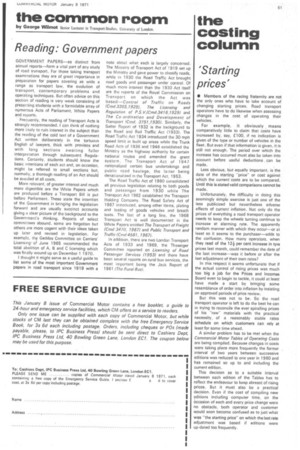the costing column
Page 53

If you've noticed an error in this article please click here to report it so we can fix it.
'Starting prices'
ID Members of the racing fraternity are not the only ones who have to take account of changing starting prices. Road transport operators have to do likewise when assessing changes in the cost of operating their vehicles.
For example, it obviously means comparatively little to claim that costs have increased by, say, £100, if no indication is given of the type or number of vehicles in the fleet. But even if that information is given, it is still not enough. The period over which the increase has occurred must also be taken into account before useful deductions can be made.
Less obvious, but equally important, is the date of the starting "price" or cost against which the current costs are to be compared. Until this is stated valid comparisons cannot be made.
Unfortunately, the difficulty in doing this seemingly simple exercise is just one of the less publicized but nevertheless adverse effects of current inflation. Not only do the prices of everything a road transport operator needs to keep the wheels turning continue to increase at alarming rate. The apparently random manner with which they occur—or at least so it seems to the purchaser—adds to the confusion. How many operators, when they read of the 121 per cent increase in tyre prices last month, could remember the date of the last increase—was it before or after the last adjustment of their own rates?
In this respect it seems unfortunate that if the actual control of rising prices was much too big a job for the Prices and Incomes Board even to begin to tackle, it could at least have made a start by bringing some resemblance of order into inflation by insisting on approved periods of price review.
But this was not to be. So the road transport operator is left to do the best he can in trying to reconcile the ever spiralling prices of his "raw" materials with the practical necessity, of a reasonably stable rates schedule on which customers can rely at least for some time ahead.
A similar problem has to be met when the Commercial Motor Tables of Operating Costs are being compiled. Because changes in•costs were taking place more frequently the former interval of two years between successive editions was reduced to one year in 1960 and has remained so up to and including the current edition.
This decision as to a suitable interval between each edition of the Tables has to reflect the endeavour to keep abreast of rising prices. But it must also be a practical decision. Even if the cost of compiling new editions including computer time, on the Occasion of each and every price change were no obstacle, both operator and customer would soon become confused as to just what was "the starting price" on which the last rate adjustment was based if editions were up-dated too frequently.












































































































































